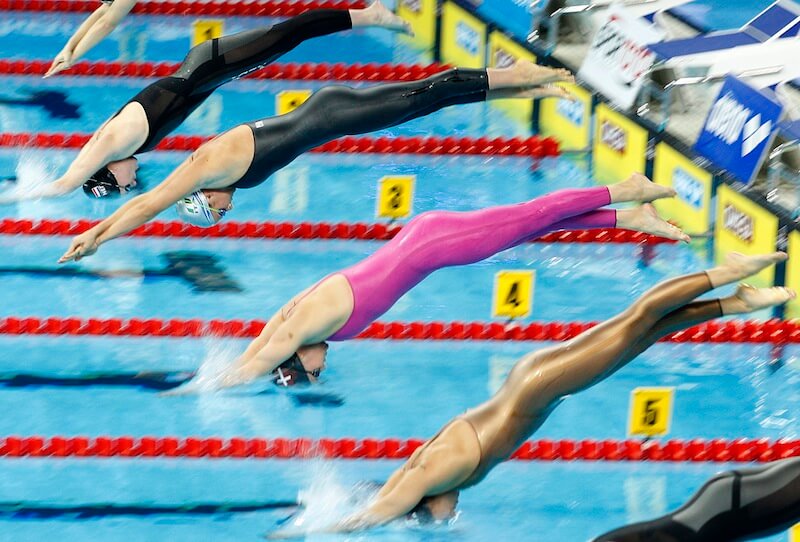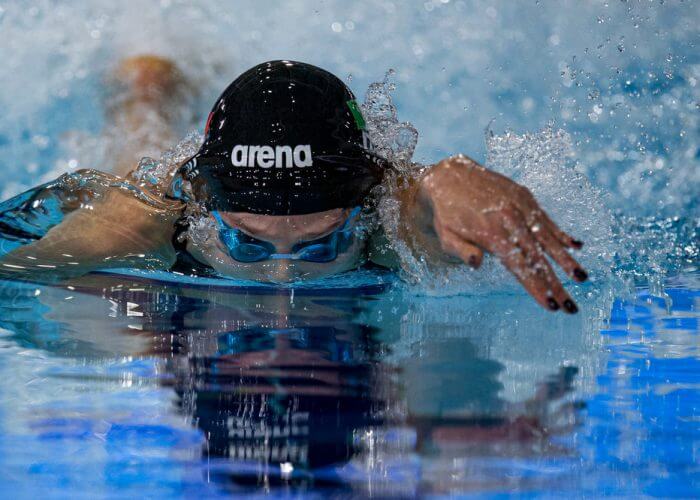Decade In The Mirror: 10 Remains Of The Day When Shiny Suits Ruled The Pool

They’d had their day a decade ago: the shiny suits – which transformed swimming into a surfers’ paradise at the expense of swimmers relying on swimming to have their swims recognised for what they were – breathed their last this day 10 years ago.
The moment coach Bob Bowman declared in Rome that his charge – Michael Phelps – would not be appearing at FINA events until a date was set to end the scam, the countdown began. We were still to endure a World Championships that would to deliver a farcical 42 global long-course standards in eight days. Even so, the decision had been taken, the date set.
The sinking of shiny suits arrived with the banning of them from January 1, 2010. The suits were made of polyurethane and other non-textile materials that treated the nuances and art of swimming skill like water off a ducks back. Much has since been made of the fact that the sport and its speed has moved the clock on.
Indeed it has. However, the bump in the road was a Himalayan like and it is likely to take another decade before the percentages of standard progress from the helm through the deep ranks of the sport return to expected “norms”.
Here are some numbers to chew over 10 years on:
1. Nine Shiny Suit World Records Survived The Decade:

Aaron Peirsol – Photo Courtesy: Jed Jacobsohn
Men
- 50m freestyle 20.91 César Cielo BRA 18 December 2009
100m freestyle 46.91 César Cielo BRA 30 July 2009
200m freestyle 1:42.00 Paul Biedermann GER 28 July 2009
400m freestyle 3:40.07 Paul Biedermann GER 26 July 2009
800m freestyle 7:32.12 Zhang Lin CHN 29 July 2009 - 200m backstroke 1:51.92 Aaron Peirsol USA 31 July 2009
400m medley 4:03.84 Michael Phelps USA 10 August 2008 - 4×100m freestyle 3:08.24
(47.51) Michael Phelps
(47.02) Garrett Weber-Gale
(47.65) Cullen Jones
(46.06) Jason Lezak
United States 11 August 2008 - 4×200m freestyle 6:58.55
(1:44.49) Michael Phelps
(1:44.13) Ricky Berens
(1:45.47) David Walters
(1:44.46) Ryan Lochte
United States 31 July 2009 - 4×100m medley 3:27.28
(52.19) Aaron Peirsol
(58.57) Eric Shanteau
(49.72) Michael Phelps
(46.80) David Walters
United States 2 August 2009

Federica Pellegrini outlived the suits and shone beyond them, her world record over 200m free never to be seen again but as the decade ends, the Italian stands as the most decorated 200m free swimmer in history with a record 8 podiums at World titles alongside her Olympic gold and silver medals won over a 15-year span – Photo Courtesy: Patrick B. Kraemer / MAGICPBK)
Women
- 200m freestyle 1:52.98 Federica Pellegrini ITA 29 July 2009
- 200m butterfly 2:01.81 Liu Zige CHN 21 October 2009
More than half of those nine World records will survive Tokyo 2020; some may survive the Olympic cycle to Paris 2024, too. Time will tell.
2. An Anomaly In The Ranks Like No Other
The impact of shiny suits far outstrips the impact of known (and any unknown) doping in terms of the historic count of swims that survived in the top 100 all-time lists across all Olympic events, men and women. Here’s what that means:
The all-time Top 100 in all Olympic events at the end of 1999 shows the following percentages of swims surviving from the 1988-89 period:
- Men: 9%
- Women: 10%
The all-time Top 100 in all Olympic events at the end of 2009 shows the following percentages of swims surviving from the 1998-99 period:
- Men: 1.5%
- Women: 1%
The all-time Top 100 in all Olympic events at the end of 2019 shows the following percentages of swims surviving from the 2008-09 period:
- Men: 26.4%
- Women: 20.3%
The low levels in the middle date range above reflect the surge reflected in the last date range and that same surge noted, in dramatic fashion, from a different angle in point 7 below.
3. The Biggest Impact
Of the percentage figures relating to 2008-09 through to 2019 above, men’s freestyle, up to 200m in distance, and butterfly events accounted for the biggest survival rates:
- 50-200m freestyle = 2008-09 account yet for 32% of all top 100 all-time performances
- 100-200m butterfly = 2008-09 account yet for 30% of all top 100 all-time performances
4. Where A Quarter Of All-Time Efforts Are Still In A Shiny
The 100m freestyle, breaststroke, butterfly and 200m freestyle had the edge of impact on other events among women, with about a quarter of all top 100 times still in the grip of the 2008-09 shiny suits season.
5. Lowest Impact – Distance Free
The lowest survival rates of shiny suit times as far at all-time 100 ranks goes are to be found in distance freestyle events. The women’s 800m rate stands at 14% and the men’s 1500m at 15%.
That’s still well above the standard rate at which performances from any given two-year period in history drop off the Top 100 chart. A deeper analysis of the stats on shiny suits confirms that their impact on distance freestyle events was real but significantly lower than the impact on events from 50 to 200m.
- Among men, the 400m free survival rate of 2008-09 performances a decade on is 10 percentage points lower than the impact seen on the 200m freestyle
- Among women, the 400m free survival rate of 2008-09 performances a decade on is 8 percentage points lower than the impact seen on the 200m freestyle
6. Off The Chart
It is extremely rare in history to find a period of between 18 months and two years that accounted for more than 20% of the all-time Top 100 lists. A general trawl of the deep World Rankings back to 1976 includes only one instance of a rate of churn above 30%: 2008-2009 – and that above 30% rate was off the chart (see point 7).
If you take the last two years of any of the past four decades, you can find events in which that close-of-decade pace accounted for 20-25% of the all-time top 100. Over 25% is rare.
7. Blue-Riband Bombshell
Using the 100m freestyle as a snapshot of the all-time rankings at the end of 2009, these were the percentages of swims from 2008-09 (the vast bulk of them from 2009, the season of 100% poly etc shiny suits):
- Men: 83%
- Women: 72%
8. Back To Standard Progress Rates?
Sticking with the 100m freestyle, the period 2018-19 accounts for the following percentage of entries in the all-time top 100:
- Men: 21%
- Women: 25%
9. The Balance Of Distance Free
Using the women’s 800m and Men’s 1500m free as the lowest impact example on shiny suits, the counts that compare with points 7 and 8 above are:
% of all-time from 2008-09 at end 2019:
- Women 800: 14
Men 1500m: 15
% of all-time from 2018-19 at end 2019:
- Women 800: 15
Men 1500m: 23




Women’s 200m fly to still be intact Jan 2030